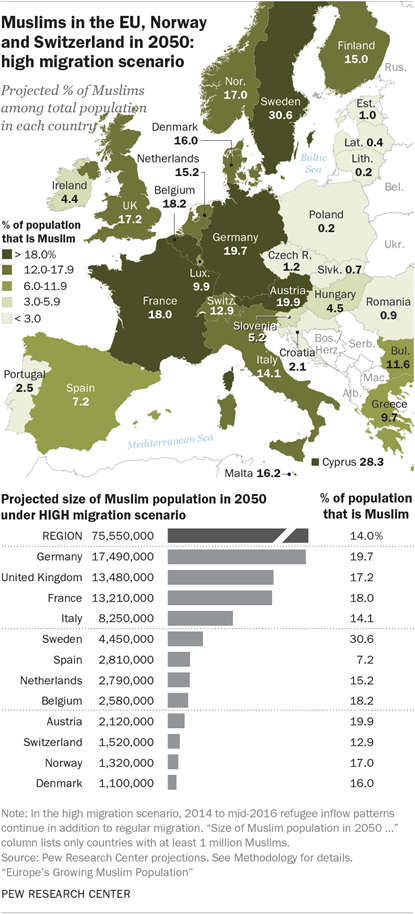Pew: Sweden 1/3 Muslim by 2050
Pew: Sweden 1/3 Muslim by 2050
Follow @KnightsTempOrgThe Muslim population of Sweden could hit 30 per cent by 2050 if current migration patterns continue, with the figure hitting 14 per cent continent-wide unless there are radical changes to Europe’s attitudes and policies towards mass migration.
Even in the unlikely case that all migration from outside the European Union suddenly and permanently ended, the new research on Europe’s rapidly shifting demographics found that by 2050 the Muslim population of the continent would hit 7.4 per cent, up from 4.9 per cent in 2016.

Immigration trends have generally shown a propensity to be at, or even beyond, the ‘high’ projections established by migration observatories in the past, with cities like London becoming minority white British faster than thought. So-called ‘white flight’, as well as higher than anticipated levels of migration to Western European nations have contributed to these trends.
Pew reports some nations will display this trend of change more clearly than others, with Sweden expected to have the highest levels of Muslim settlement by 2050, at a projected 30.6 per cent. Sweden will be followed by fellow high migration nations Austria, Germany, and France, at between 18 and 19.9 per cent Muslim population.
The United Kingdom follows closely behind in projected growth, with a projected 17.2 per cent of residents in 2050 under the high projection predicted to be of the Muslim faith.
While Pew reports that mass migration will continue to be the main driver of these changes, that even the zero migration model shows continued growth reveals that other factors are at work. High birthrates among Muslim communities is one cause, as is the projected 160,000 European residents who will convert to Islam.
The growth is not universal, however, with some — predominantly Eastern European — nations avoiding a significant rise. Even under the high growth model, Poland’s Muslim population is only projected to hit 0.2 per cent by 2050.
Poland and other Eastern and Central European nations like Hungary have been pursuing a policy of rejecting forced migrant resettlement by the European Union. A recent poll of Polish citizens found that a majority would rather leave the European Union — continued membership of which remains widely popular in the country — than be forced to take Muslim migrants.
 |
 |


